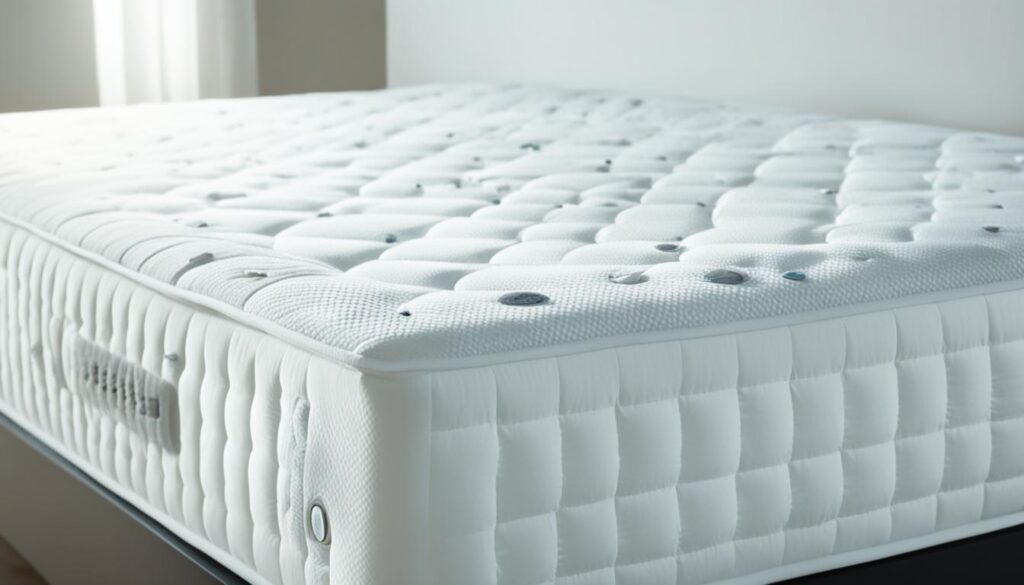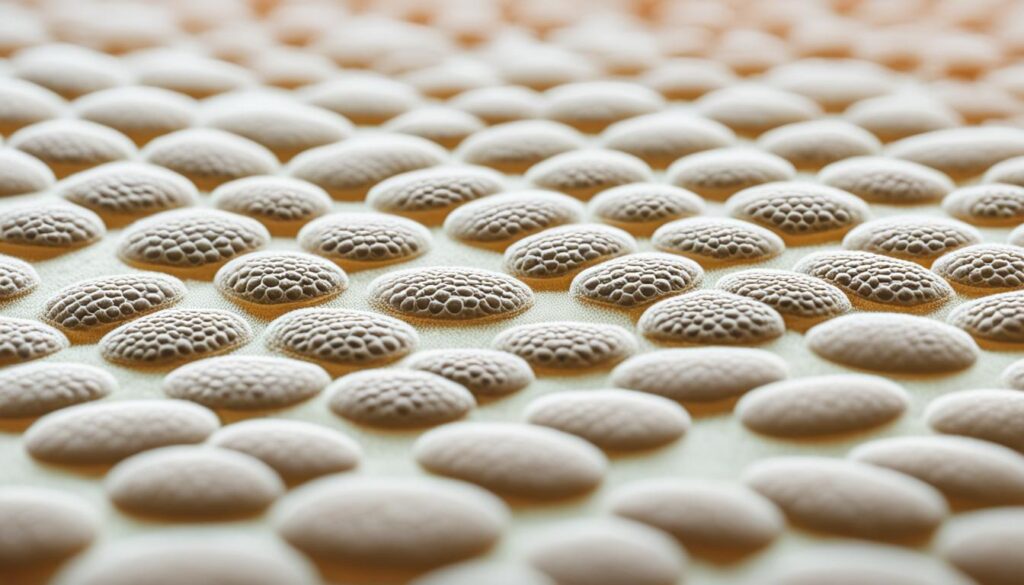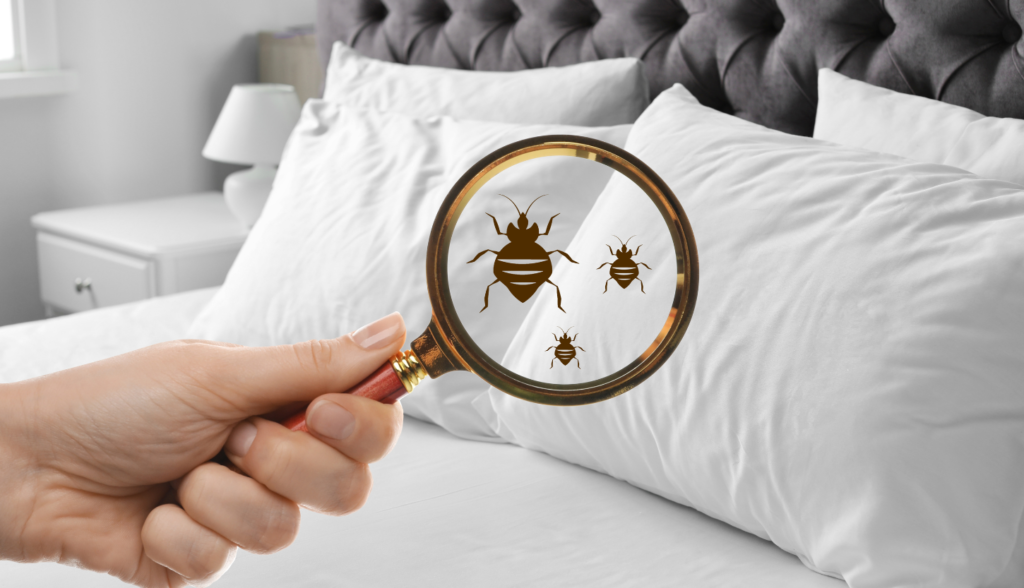Ever thought your mattress might be home to bed bugs? Living in Madison, Alabama, I’ve seen how common this problem is. I’m here to give you a quick guide on checking your mattress for bed bugs. But first, have you ever wondered what signs to look for when checking your mattress for bed bugs?

A close-up view of a white mattress with a flashlight shining on it, revealing small dark spots and tiny bugs. The mattress is positioned in a well-lit room with neutral-colored walls and minimal decor. There are no people or furniture visible in the image.
Key Takeaways
- Understand the importance of regularly inspecting your mattress for bed bugs
- Learn to identify the common signs of bed bug infestation on your mattress
- Discover the essential steps to thoroughly inspect your mattress for bed bug evidence
- Gain confidence in your ability to detect and address bed bug issues proactively
- Discover practical prevention strategies to maintain a bed bug-free home
Introduction
Bed bugs can be a big problem, but checking your mattress often can help catch them early. This way, you can act fast. I’ll explain why it’s key to check for bed bugs and show you the signs to look for. This will help you spot and deal with any issues early.
Why You Should Check for Bed Bugs
Bed bugs are tiny and hard to see until they multiply. Checking for bed bugs on your mattress is important for several reasons:
- Early detection: Finding bed bugs early makes getting rid of them easier before they spread.
- Prevent bites and discomfort: Spotting bed bug bites quickly helps avoid the itch and discomfort they cause.
- Avoid costly extermination: Ignoring bed bugs can lead to a big problem that’s hard and expensive to fix. Inspecting your mattress for bed bugs is a smart move to save money.
Common Signs of Bed Bug Infestation
When inspecting your mattress for bed bugs, watch for these signs:
- Small, brownish-red bugs: Look for bugs the size of an apple seed crawling on your mattress.
- Dark spots or stains: Bed bug droppings and crushed bugs can leave behind small, dark spots.
- Shed skins: As they grow, bed bugs shed their skins, leaving behind thin, translucent casings.
- Musty odor: A sweet, musty smell means bed bugs might be around.
Knowing the importance of checking for bed bugs on your mattress and spotting the signs early will help you fight this problem effectively.
Preparing for the Inspection
Before you start checking your mattress for bed bugs, make sure you have everything you need. It’s important to prepare well for a complete and successful check.
You’ll need these items to begin:
- A bright flashlight or LED lamp to illuminate hard-to-see areas
- A magnifying glass to closely examine small details
- A rigid, flat tool like a credit card or putty knife to help inspect crevices and seams
- A clean, well-lit area where you can thoroughly inspect the mattress
After getting your supplies, pick a good spot for the inspection. Choose a room with lots of light and enough space to move around the bed. This makes it easier to inspect the mattress for bed bugs and detect any signs of bed bug infestation.
Clear the area around the mattress before you start. Remove any bedding, pillows, or other items that might block your view. A clean workspace helps you focus better and do a thorough mattress inspection.
With everything set, you’re ready to check your mattress for bed bugs. Remember, being careful and thorough is important. This way, you won’t miss any bugs that might be hiding.
Inspecting the Mattress
Checking for bed bug infestation on mattress starts with the mattress itself. Bed bugs often live here, feeding on people while they sleep. Let’s look at how to inspect the mattress for these pests.
Examining the Seams and Piping
Begin by checking the seams and piping of the mattress. Bed bugs hide in these tight spaces. Run your fingers along the seams to feel for bumps or live bugs. Also, check the piping for hiding spots.
Checking the Mattress Edges and Corners
Don’t miss the edges and corners of the mattress. These spots can have many bed bugs. Lift the mattress to check the underside and box spring for signs of bed bugs. Look for droppings, shed skins, or live bugs.
By carefully inspecting the mattress, you can find out if you have a bed bug infestation. If you think there’s a problem, call a professional. Your comfort and peace of mind are important.
How to Check for Bed Bugs on Mattress
Checking your mattress for bed bugs is key to catching an infestation early. A detailed inspection helps you spot these pests and deal with them fast. Here’s how to check your mattress for bed bug signs.
Begin by looking at the seams and piping of your mattress. Use a flashlight and magnifying glass to see every nook and cranny. Bed bugs like to hide in small spaces. Look for their poop, which looks like tiny dark spots, and the bugs themselves.
- Inspect the mattress edges and corners, as these are common hiding spots for bed bugs.
- Check the mattress tag and label for any signs of bed bug activity, such as shed skins or egg casings.
- Lift the mattress and examine the box spring as well, as bed bugs can also infest this area.
If you think your mattress has bed bugs, act fast. Call a professional exterminator to check and fix the problem. Taking action quickly helps keep your home safe and ensures you sleep well without bed bugs.
| Signs of Bed Bugs in Mattress | What to Look For |
|---|---|
| Bed bug bites | Itchy, red welts that appear in a linear pattern |
| Bed bug droppings | Small, dark spots or smears on the mattress or bedding |
| Shed bed bug skins | Translucent, hollow casings left behind as the bugs molt |
| Bed bug eggs | Tiny, white, oval-shaped eggs, often found in cracks and crevices |
| Live bed bugs | The insects themselves, often hiding in seams, folds, or corners of the mattress |
Regular checks and being alert are crucial to keep your home bed bug-free. By following these steps, you can stay on top of the problem and sleep well.

A close-up of a mattress with multiple small, oval-shaped insects of reddish-brown color, some crawling and others still, in different shades and sizes. The texture of the mattress is visible along with some creases and folds. The background is blurred to put emphasis on the bugs.
Inspecting the Box Spring
When dealing with bed bug infestation on mattress, don’t forget to check the box spring too. This often-overlooked area can be a hiding spot for bed bugs. It’s key to inspect the box spring during a mattress bed bug inspection.
Removing the Dust Cover
To start inspecting the box spring, remove the dust cover. This cover can hide signs of looking for bed bugs in mattress. Here’s how to do it:
- Find the dust cover, usually stapled or secured around the box spring edges.
- Carefully peel back the dust cover without tearing it.
- After removing the cover, look inside the box spring for bed bug signs like eggs, skins, or bugs.
Focus on seams, crevices, and other hiding spots for bed bugs. A thorough check will help spot any infestations early.
Inspecting both the mattress and box spring ensures you’ve checked everything. This way, you can catch any bed bug issues early and keep your bed bug-free.
Checking Other Areas
When looking for bed bugs, don’t just focus on your mattress and box spring. These pests can also hide in other spots in your bedroom. Make sure to check all areas to catch any potential hiding spots.
Begin by examining your bedframe closely. Look at any cracks, crevices, or joints where bed bugs might hide. Use a flashlight to see every nook and cranny. Check for signs like small dark spots, shed skins, or the bugs themselves.
Then, move on to the area around your bed. Inspect the baseboards, furniture, and even the walls. Bed bugs can squeeze into tiny openings, so be thorough.
Don’t skip upholstered furniture like chairs or sofas. Bed bugs can infest these items, hiding in small crevices and folds.
Being thorough and methodical is key when checking for bed bugs. By inspecting all possible hiding spots, you’ll be more likely to find and deal with any issues early.
| Area to Check | Signs of Bed Bug Presence |
|---|---|
| Bedframe | Small dark spots, shed skins, live insects |
| Baseboards | Small dark spots, shed skins, live insects |
| Nearby Furniture | Small dark spots, shed skins, live insects |
| Upholstered Furniture | Small dark spots, shed skins, live insects |
By checking mattress for bed bug evidence and other areas, you can spot a bed bug presence early. This helps you take action quickly.
A close-up view of a mattress with a magnifying glass focusing on a tiny bed bug crawling among the fibers.
What to Do if You Find Bed Bugs
If you find bed bugs on your mattress, act fast. Quick action is key to stop the infestation from getting worse. This will also help keep your home peaceful.
Contacting a Professional Exterminator
Getting help from a professional exterminator is the best step. They know how to spot and get rid of bed bugs on your mattress. They’ll figure out how bad the problem is and make a plan to get rid of all the pests.
When picking an exterminator, do your homework. Choose a company known for getting rid of bed bugs well. Make sure they use integrated pest management (IPM) methods. This means they use different ways to solve the problem at its source.
- Thorough inspection of the entire home or apartment
- Application of specialized treatments, such as heat treatment or chemical sprays
- Ongoing monitoring and follow-up visits to ensure the bed bug presence on mattress is completely eliminated
Working with a professional exterminator is the smart way to deal with bed bug infestations on mattresses. They have the skills and methods to make your home safe from these pests. This will give you peace of mind.
Prevention Strategies
Keeping your home bed bug-free starts with prevention. A top strategy is to cover your mattress and box spring with special covers. These covers stop bed bugs from getting in or out. They trap bed bugs inside and keep new ones away.
Encasing Mattresses and Box Springs
Buying good mattress and box spring covers is a smart move to prevent bed bugs on mattress. Look for covers made of strong, breathable fabric with a tight zipper. These covers seal off entry points, making it hard for bed bugs to live in your bedroom.
- Choose encasements that fit your mattress and box spring size.
- Make sure the covers don’t have any tears or holes.
- Check the covers often for damage and replace them when needed.
By checking for bed bugs on mattress and using covers, you can lower the chance of bed bugs. This keeps your sleep area comfortable and free from pests.
“An ounce of prevention is worth a pound of cure when it comes to bed bugs. Investing in quality encasements is one of the best ways to protect your home.”
Conclusion
In my quest for a healthy, pest-free home in Madison, Alabama, checking my mattress for bed bugs is key. This article has given me the tools to spot bed bug signs and act fast. I’ve learned how to inspect my mattress well.
Now, I know how to look at the seams, edges, and corners for bed bug signs. I’ve found their bites, skins, and even the bugs themselves. Also, I know to check the box spring and nearby areas for more signs.
Now, I’m ready to keep an eye on my mattress for bed bugs. I plan to use strategies like encasing my mattress and box spring. With vigilance and proactive steps, I aim to keep my home pest-free. This way, I can sleep well in my Madison, Alabama home.
Frequently Asked Questions
What are the common signs of bed bug infestation on a mattress?
Look for small bloodstains from bites, tiny black or brown spots (their poop), and shed skins. Also, watch out for the bed bugs themselves. They are small, brownish-red insects.
How do I effectively inspect my mattress for bed bugs?
Start by checking the seams and piping of your mattress. Bed bugs often hide there. Also, inspect the edges and corners. Use a flashlight and magnifying glass to spot signs of bed bugs.
What should I do if I find bed bugs on my mattress?
If you find bed bugs, call a professional exterminator right away. They can identify the problem and create a plan to get rid of the bed bugs. This will also help stop them from spreading.
How can I prevent bed bugs from infesting my mattress in the future?
Use protective covers for your mattress and box spring to keep bed bugs out. Regularly check your bedroom for any signs of bed bugs. Keeping your room clean and clutter-free also helps prevent infestations.
Do I need to throw away my mattress if I find bed bugs?
No, you don’t always have to throw away your mattress. A professional can treat the infestation without needing a new mattress. But, if the infestation is severe or the mattress is badly damaged, getting a new one might be best.

